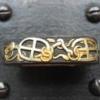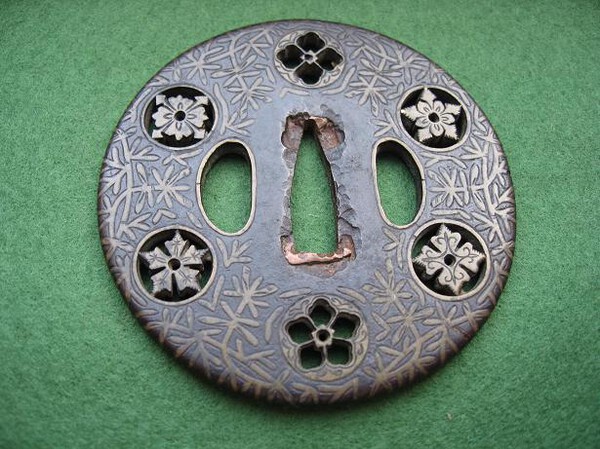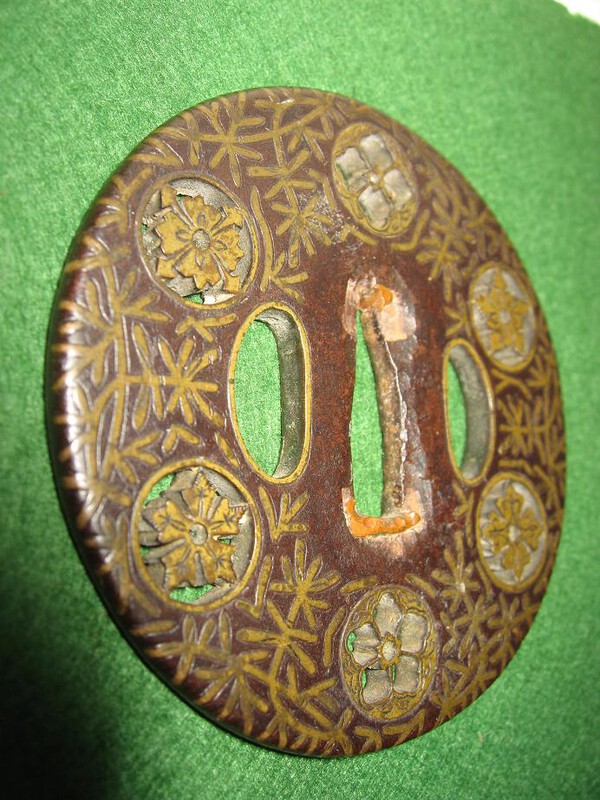-
Posts
198 -
Joined
-
Last visited
Everything posted by Davis
-
Brian I won't be able to obtain further pictures for a while - not that they would add much anyway. My sword too, exhibits the activity you refer to, although nowhere near as pronounced. During the last 25 years I have only handled one other sword by him and seen about eight references to others. Of these, most were special order blades. So, I have concluded that although not prolific his work was highly favoured.. All seemed to share the same flamboyant hamon and detailed activity. I should also imagine that whatever showed on his finished blades, was what he intended, otherwise he would not have put his name to them. I have owned a good number of gendaito, all now gone bar this Moritsugu Norisada. I believe the former Japanese owner of mine saw action in the field as the sword came with a battered n.c.o's leather knot and a bullet/shrapnel graze to it's saya. To me it is a privilege to be it's present custodian, a piece of military history yet a fine work of art too. Therefore I can share the enthusiasm that you obviously have for yours. Mick
-
Brian I managed to get a quick shot of my blade before returning it to storage. Unfortunately I didn't have the time to do better.Mine too has some corrosion, like yours a deep rich black not the normal red/brown colour that you would expect on a sword of this age. I'll get some more pictures/details when time allows. Mick
-
Brian From memory, it has a very flamboyant choji-midare mix. I have onley seen one other sword by this smith. He seemed to have concentrated on very high quality work and could not have made very many of this standard during the time that he was active. Look forward to seeing some more pictures. Mick
-
Evening Brian Digging through an old file I found some transalation notes I made when I acquired my sword. I might be a little wrong on the date though, looking at it again. I'.m still searching for other details. Mick
-
Hi Brian I'm not sure if this is of interest. It's an old photo of a sword that I have in storage. This one I believe reads "made by Moritsugu Norisada living at Fukuoka in Chikuzen Province". I'm busy with some building work at the moment but if you are interested I will give further details as and when. Regards Mick
-
Dear Ron, You have started a very interesting debate. I have tried to visualize how Samurai would have used your kaginawa. To climb a rope, the rope would have to have been strong enough to support a persons weight, it would also have to have a circumference that could be comftably gripped. Attaching such a rope to your kaginawa ( weight 1lb apprx.) would not allow it to be thrown very far vertically, the weight of the rope would act as a downward drag. Your kaginawa could however have been used with a combination of different sized ropes utilizing knots such as a double sheetbend and running bowline. The application of which would be too detailed to go into here. Many years ago in the course of my then employment I was trained in the use of hook and scaling ladders. The idea was that they could be used to gain access to buildings where conventional ladders could not be deployed - due to restricted space - rear of hotels, tenements etc. The hook ladder was of lightweight construction, 13' 6" long and had a 2' serrated hook. The person using it would also wear a "hookbelt" which attached to it were a large snaphook, axe and bobbing line. The boobing line was a 100' long and weighed about 2lb. An improvised grappling hook could be made using the line tied to the axe. It wasn't particularly effective as the bobbing line could never be climbed. A normal sized line (rope) had to be attached to it and pulled through. Many years ago I was shown a wartime documentary of British commandos training to scale cliffs. They were using grappling hooks fired from mortar like devices.. Schermuly rockets could no doubt be adapted to the same principle. Ron, your description of my Meiji period bronze is pretty accurate. However, the picture doesn't show the opening at the top which has been used to place incense in the past. A Japanese specialist at a London museum also thought that it was a koro. I believe Christies sold a pair of them similiar to mine at a sale in London during 2012, describing them as koro. You were also right to pick up on the patination. A previous owner has almost ruined it in the past by cleaning it with abrasive metal polish. but time is again allowing it to mellow. A very interesting subject, thanks again Ron. Regards MIck
-
Ron Thanks for the very interesting links. I once read that in Old Japan, firemen attending a blaze would have a standard bearer, who would plant his banner into the ground and stand alongside it whatever happened, even if the fire advanced upon him. Whether this is true or not I don't know. Also read that firemen together with yakusa were very keen on full body tattoos. Getting back to the main subject, I'm posting a picture of a koro that I have, hope it's of interest. Mick
-
I was having trouble typing my last post (red squiggly underline everytime I typed the word tsuba - "browse" disappearing etc., ) I had to type it several times and when I finally submitted it, realised it didn't make much sense. Thanks John and Arnold, of course they are "kenuki" menuki, I was concentrating on a particular thought to the exclusion of everything else. Pete, yes I too think the background is a screen. Thanks for the appreciation of the tsuba Pete and Arnold. The indentations? They could be dust/debris to be swept away with the feather or possibly steam from the boiling water. Thanks everyone for your thoughts and input. Mick
-
Chris, I can understand why you thought Benkei.... Arnold, Pete, your thoughts echo mine. Any ideas though on the background crosshatching and indentations? I believe that the koshirae accompanying the tsuba may have a Buddhist symbolism, menuki especially. Mick
-
Hi All Does anyone have any thoughts on the theme of this tsuba? Regards Mick
-
Visiting Mike Dean's shop in St Giles High Street was like stepping back in time to another era. He had at least two racks of very fine swords. When he later moved shop to Museum Street he didn't seem to carry as many in his stock and on the last occasion I visited there he only had one sword. His interest then seemed to be concentrated on Lacquer work. I also remember John Harding, never really spoke to him, just listened and tried to learn. Sidney Divers (also in the photograph) had I believe a very fine collection at "Hunters Moon". On one occasion the ToKen organised an auction at one of the regular meetings at the Princess Louise, a pub in Holborn. Members had been asked to bring surplus items from their collections that they no longer wanted. As about 40 members turned up, many bringing swords, etc it was a very good evening. Sidney Divers seemed to buy up virtually everything. I didn't enter the bidding as there were to many very knowledgeable people present. However, after the "sale" I timidly approached Sidney and asked him if he would sell me one of the swords he had just bought, if I gave him a small profit. He knew that I was new to collecting and he agreed. So I walked from that meeting with a reasonable shinshinto katana for £35. Those were the days. Mick
-
My knowledge of tsuba is negligible but I still found this discussion very interesting. I have something similiar. All I can say for certain, is that it is 7cm x 7cm x3mm. The walls of the sukashi mons/flowers seem to have a coat of verdigris/old wax. The brass is definately inset into the iron. How old can it be, is mine a later copy? Regards Mick
-
Morita San Thank you for your fast and informative response. It is always interesting to have detailed information, as there is always a story behind each picture. A moment of time frozen in history. Thank you. Regards Mick
-
Morita San I am very grateful for your kind assistance. I found this photo last year at a flea market and it intrigued me. I am not a dealer but began collecting photographs relating to the Sword about 45 years ago. At one time my collection was extensive but over the years I have donated most of them to authors/researchers and now only retain perhaps a dozen or so of the more interesting. Thank you once again. Regards Mick
-
Hi all Anyone have any ideas on the purpose of this seal, on a military saya? The gendaito blade is by Moritsugu Norisada. Mick
-
-
Hi Does anyone have any information on the military mounted swords worn by Emperor Hirohito during the early Showa period? Regards Mick
-
-
Hi It is said that Japanese Officers' wrapped the hilts of their swords as a sign of mourning. Is there any evidence for this? My photo shows three types of hilt covering, 1. Leather encompassing both hilt and tsuba 2. Leather, sleeve only, 3. The ubiquitous white cloth cover. A 1938 dated photo I recently posted, even shows a boy with the hilt of the sword he is posing with wrapped in white cloth. Is it possible that these white wrapped hilts were nothing more than temporary, improvised additions just to keep the hilt clean and protected from inclement weather? Regards Mick
-
Hi I removed these from a distressed tsuka and gave them a gentle clean. Does anyone have any ideas as to age, school and the subject? Do they depict horse bits or a subtle show of allegiance to a particular clan? I have an open mind and no firm opinions but would welcome yours. Mick
-
-
Hoanh Thank you for your objective comments. The boshi is authentic, not etched on but possibly enhanced. It is, in reality much better than my poor photographic skills allow me to show. The blade has been attacked with a grinding wheel at some stage and this does obscure detail but I feel that it does have a good shape. The Eisho date would suggest that it is 500 years old but I too, do not, think it is as old as this. Regards Mick
-
Hi Josh Yes, so would I. I've tried taking more pictures but can't seem to capture the details. This one shows the hamon at the expense of other detail. I bought this sword from a Dutch guy selling from the boot of his car - he had a lot of antique weapons but nothing else Japanese. Regards Mick
-

British soldiers and the Japanese Sword
Davis replied to Davis's topic in General Nihonto Related Discussion
Hi Glancing through Clive Sinclaire's excellent book Samurai Swords (p.8/9), I realise I should have also added the name of Captain Raymond Jonnes who carried a tachi in the trenches of northern France during the First World War. Mick -
Hi Thank you all for your replies. This smith would appear to have worked around the late Muromachi period as it is dated to the Eisho era. It appears to me, to have a sugata of fine shape. Nagasa 42.5cm, moto-haba 2.5cm, saki-haba 1.7cm, sori 1.0 cms. Suguha hamon, ko-maru boshi with a short kaeri. Unfortunately, it has been heavily abraided but the lines of the blade are intact and there is still much meat left. I have made a number of attempts to photograph the blade but am unhappy with the results, I will keep on trying. Mick











